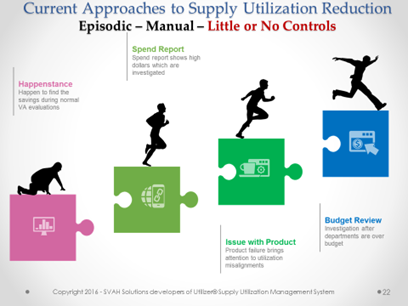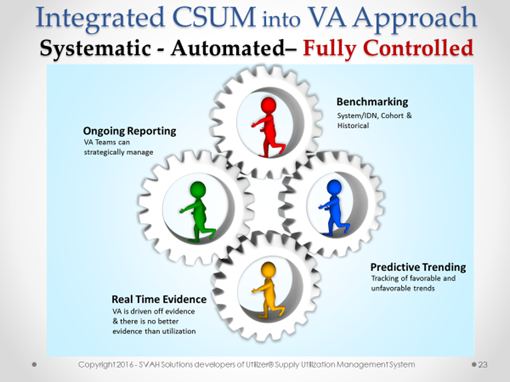How can you get your supply chain organization ready for clinical supply utilization management (CSUM)? How can you bridge the supply utilization gap in your hospital value analysis program? For the answers to these questions, let’s look at figure 1 to see how hospitals, systems, and IDNs are uncovering their supply utilization misalignments (e.g., wasteful and inefficient consumption, misuse, misapplication, or value mismatches in a supply stream) now.
Figure 1

A hospital supply chain manager or healthcare value analysis practitioner stumbles on a utilization misalignment category and decides to investigate, is informed of a product failure, or a budget item surfaces that is a utilization misalignment. These are happenstances, not a system that brings about behavioral change and savings and quality improvements. This isn’t the way to bridge the supply utilization gap with your value analysis program. So how do you do it?
CSUM Needs To Be a Systematic VA Process
First off, your value analysis teams need to have ongoing reporting of your hospital, system, or IDN’s utilization misalignments. This is accomplished by benchmarking internally, historically, and externally to determine if your products, services, and technologies are within acceptable limits. This can give your value analysis teams real-time evidence that you’re not in step with the marketplace and provide predictive trending that says if you stay on this course some of your products, services, and technologies will turn into utilization misalignments.
Figure 2

This is the systematic and fully automatic system shown in Figure 2 that your hospital value analysis program should be employing to uncover all of your current and new utilization misalignments. To expand on the CSUM system, described in Figure 2, we would like to review specific elements on which you need to focus to be successful:
- Reporting: You need to identify your healthcare organization’s utilization misalignments before your value analysis teams can do anything about them. This can only be accomplished by continually monitoring your purchasing patterns and practices. You need validation that implemented changes (i.e., price, substitution, or standardization) have stuck and to provide hard evidence that a change is needed to fix cost or quality challenges.
- Training: Don’t expect your value analysis team members to instantly know how to measure, monitor, and manage your healthcare organization’s utilization misalignments. This is a skill set that needs to be learned, not on the job, but in the classroom, since better training ensures better results.
- Management Buy-In: If your senior management “gets it,” your utilization management efforts will be so much easier. That’s why you need to help them understand the upside (savings and quality improvements) if and when your value analysis bridges the CSUM gap.
In the final analysis, you need a system that your value analysis team(s) plugs into to identify and eliminate your utilization misalignments. It’s not a onetime thing, but a continuous process to weed out wasteful and inefficient consumption practices in your healthcare organization.
Below are some similar articles that you may find interesting.
Integrating CSUM Into Your Healthcare Value Analysis Program
